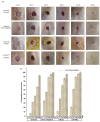Nanogels as Potential Delivery Vehicles in Improving the Therapeutic Efficacy of Phytopharmaceuticals
- PMID: 36236089
- PMCID: PMC9570606
- DOI: 10.3390/polym14194141
Nanogels as Potential Delivery Vehicles in Improving the Therapeutic Efficacy of Phytopharmaceuticals
Abstract
Nanogel is a promising drug delivery approach to improve the pharmacokinetics and pharmacodynamic prospect of phytopharmaceuticals. In the present review, phytopharmaceuticals with astonishing therapeutic utilities are being explored. However, their in vivo delivery is challenging, owing to poor biopharmaceutical attributes that impact their drug release profile, skin penetration, and the reach of optimal therapeutic concentrations to the target site. Nanogel and its advanced version in the form of nanoemulgel (oil-in-water nanoemulsion integrated gel matrix) offer better therapeutic prospects than other conventional counterparts for improving the biopharmaceutical attributes and thus therapeutic efficacy of phytopharmaceuticals. Nanoemulgel-loaded phytopharmaceuticals could substantially improve permeation behavior across skin barriers, subsequently enhancing the delivery and therapeutic effectiveness of the bioactive compound. Furthermore, the thixotropic characteristics of polymeric hydrogel utilized in the fabrication of nanogel/nanoemulgel-based drug delivery systems have also imparted improvements in the biopharmaceutical attributes of loaded phytopharmaceuticals. This formulation approach is about to be rife in the coming decades. Thus, the current review throws light on the recent studies demonstrating the role of nanogels in enhancing the delivery of bioactive compounds for treating various disease conditions and the challenges faced in their clinical translation.
Keywords: biopharmaceutical attributes; nanoemulgel; nanogels; phytopharmaceuticals; skin permeation; therapeutic efficacy; thixotropy.
Conflict of interest statement
The authors declare no conflict of interest.
Figures






References
-
- Hydrogel-Based Drug Delivery System Market Size, Share & Trends Analysis Report by Polymer Origin (Natural, Synthetic, Hybrid), by Route (Subcutaneous, Ocular, Oral Cavity), by Region, and Segment Forecasts. [(accessed on 5 September 2022)]. Available online: https://www.grandviewresearch.com/industry-analysis/hydrogel-based-drug-....
-
- Calvert P. Hydrogels for soft machines. Adv. Mater. 2009;21:743–756. doi: 10.1002/adma.200800534. - DOI
-
- Arakaki K., Kitamura N., Fujiki H., Kurokawa T., Iwamoto M., Ueno M., Kanaya F., Osada Y., Gong J.P., Yasuda K. Artificial cartilage made from a novel double-network hydrogel: In vivo effects on the normal cartilage and ex vivo evaluation of the friction property. J. Biomed. Mater. Res. A. 2010;93:1160–1168. - PubMed
Publication types
Grants and funding
LinkOut - more resources
Full Text Sources

